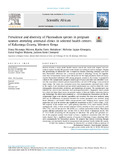Prevalence and diversity of Plasmodium species in pregnant women attending antenatal clinics in selected health centers of Kakamega County, Western Kenya
Date
2022-10-11Author
Waiswa, Diana Musungu
Mukabane, Kipcho Davis
Kitungulu, Nicholas Ligayo
Mulama, David Hughes
Cheruyoit, Jackson Korir
Metadata
Show full item recordAbstract
Malaria remains a major public health concern around the world with tropical and sub-tropical regions bearing the greatest brunt despite up-scaling of control strategies. Despite the provisioning of insecticidal nets to expectant women attending antenatal care facilities, Plasmodium infections was a recurrent problem in Kakamega County. We hypothesized that socioeconomic factors were risk factors for the high prevalence levels of asymptomatic Plasmodium infections (API) among pregnant women in the County. A prospective cohort of 304 asymptomatic pregnant women aged 18 years and older was identified to assess the association between patient characteristics and risk of API using a cross-sectional study design. The study was conducted across four representative antenatal clinics (ANC) in the region. A pre-structured and pre-tested questionnaire was used to obtain the socio-demographic characteristics, residence, and knowledge of malaria. The questionnaire was followed by a face-to-face interview. Each participant provided a fingerprick blood sample for a thick and thion blood smear for parasite studies at Masinde Muliro University Science and Technology. The slides were examined at ×100 oil immersion. Plasmodium and the developmental stages were checked, quantified, and recorded. The data were analyzed using SPSS ver 16. Differences in parasite densities for various parameters was assessed using Mann Whitney U and Kruskal Wallis non-parametric tests. Ordinary linear squares (OLS) regression was used to uncover any significant associations at 95% CI and p-value ≤ 0.05. The majority of the women had a post-primary education (75%), were married (60.9%), multigravidae (50%), in their second trimester (41.4%), residing in rural areas (62.2%), used ITNs (77%), and did not practice IRS (67.8%) as a malaria prevention method. Plasmodium species infection prevalence was (24.34%; 95% CI, 19.52–29.16) P. falciparum (82.4%; 95% CI 73.72–91.08) accounting for the majority of infections. The parity and gestation status of the pregnant women were found to have a significant association with API. This study showed that a significant number of women in Kakamega County attending ANCs were asymptomatic for Plasmodium malaria. We propose that malaria screening through microscopy and treatment should be incorporated into maternal health within the county.
URI
https://www.sciencedirect.com/science/article/pii/S2468227622002988https://doi.org/10.1016/j.sciaf.2022.e01392
http://ir-library.mmust.ac.ke:8080/xmlui/handle/123456789/2108
Collections
- Gold Collection [1011]

